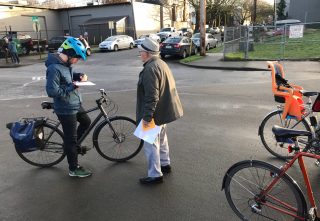
(Photo: Emily Guise)
They offered free coffee and donuts, and some bad news: The bridge they were giving it out on will be removed if the Oregon Department of Transportation ever breaks ground on their $450 million I-5 Rose Quarter project.
Volunteers from the No More Freeways coalition and Bike Loud PDX hosted the event with an aim to educate people about the project and add signatures to a petition they plan to deliver to Portland City Council this Thursday.
I was there for just a few minutes and was surprised to be greeted by Jim Howell and Ron Buel, two veterans of Portland’s past freeway fights. They were both eager to show me a strip of grassy hillside adjacent to the current I-5 freeway that separates thousands of polluting cars from students at Harriet Tubman Middle School. “That’s where ODOT wants to put the new lanes,” Buel said.
No More Freeways organizer Aaron Brown said nearly 100 people stopped to sign their petition (which is open until tomorrow at 2:00 pm) that reads: “The Rose Quarter Freeway Expansion is #NotAnImprovement to the local streets of North and Northeast Portland. This $450 million freeway is already demonstrably proven to not have any positive impact on congestion relief, will not adequately address the true safety concerns on Portland’s streets, will exacerbate existing unhealthy poor air quality near Harriet Tubman Middle School, and will hinder our ambitious carbon emission initiatives.” So far the petition has about 200 names.
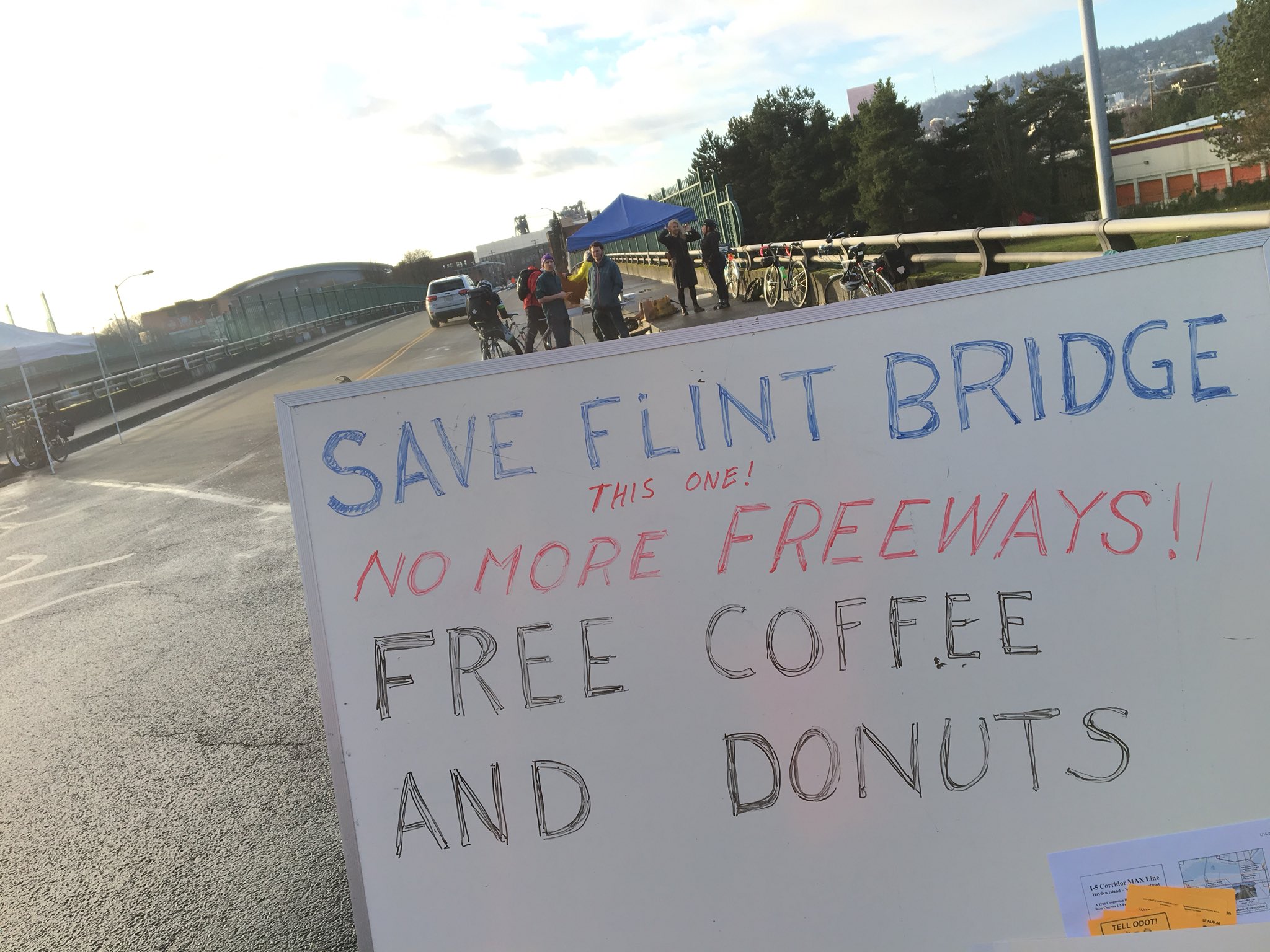
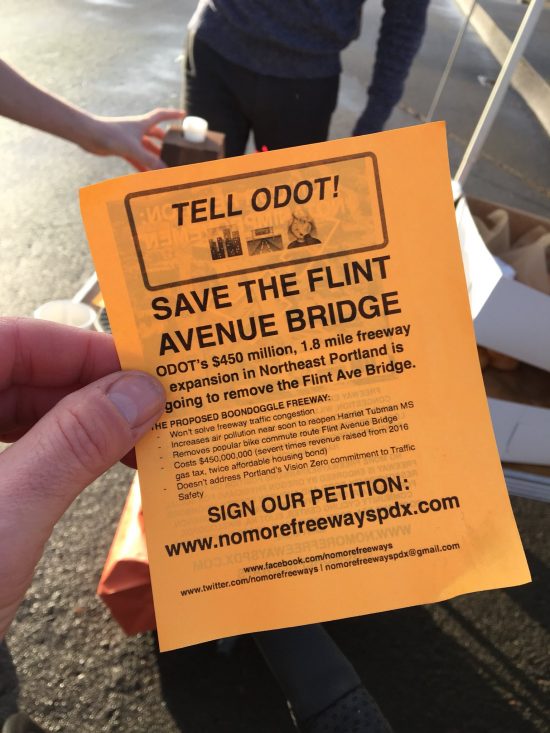
Advertisement
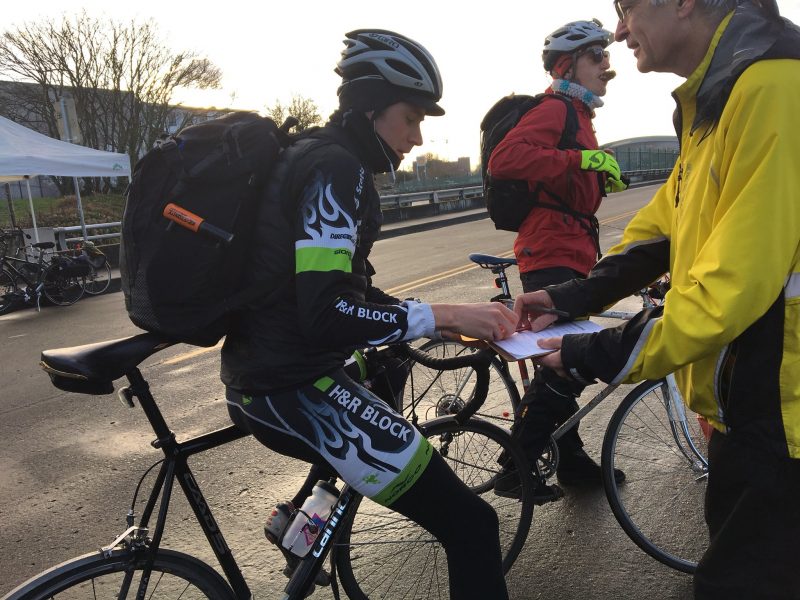
Emily Guise is the co-chair of Bike Loud PDX and worked a shift at the event this morning: “We were able to raise a lot of awareness about the proposed removal of bridge and the other proposed bike/ped changes, as this was the first time many people had heard about it,” she shared with us in a follow-up email.
One of our readers contacted via Twitter said, “Biking past them today was the first time I’d ever heard of it! I would hate it if that bridge was gone. There really is no better way to get onto Broadway.”
ODOT’s plans are to remove the Flint Avenue bridge and replace it with new crossing that will connect between Hancock and Dixon.
— Jonathan Maus: (503) 706-8804, @jonathan_maus on Twitter and jonathan@bikeportland.org
Never miss a story. Sign-up for the daily BP Headlines email.
BikePortland needs your support.




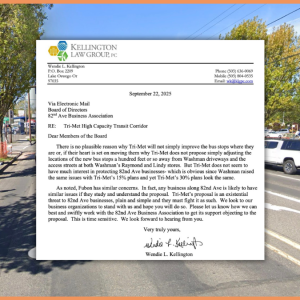
Thanks for reading.
BikePortland has served this community with independent community journalism since 2005. We rely on subscriptions from readers like you to survive. Your financial support is vital in keeping this valuable resource alive and well.
Please subscribe today to strengthen and expand our work.
Cheers to Aaron Brown, Emily Guise, No More Freeways, and Bike Loud PDX for their work on this issue!
“Save the Flint Ave. Bridge” may not be the best rallying cry for pro-bicycle/pedestrian anti-freeway activists. The bike/ped rationale for preferring Flint Ave. over the proposed Hancock/Dixon crossing is not strong.
While I am no fan of freeway expansion, I do recognize the importance of not forfeiting my opportunities to help influence specific aspects of the plan should the freeway expansion project prove to be inevitable.
For example, while continuing to protest the freeway expansion on more solid grounds, like cost and induced demand, maybe we should also be looking at the surface street changes that are proposed. In case the the plan does go through, or in case the TDM trial solves the freeway problem but the land use and surface street aspects of the project are still implemented, we want to understand and perhaps influence those changes.
And also, let’s hold ODOT and PBOT to the promises made for the project. For example, speaking of Flint, the map included in this BP article and currently being disseminated by ODOT online, to the press, and at public info sessions omits two “potential” MUPS that connect Flint from Tillamook to Broadway. These are clearly shown on the plan that was finalized and adopted by City Council and the Oregon Transportation Commission in October 2012. Where are they now? https://www.portlandoregon.gov/bps/article/422031 p. 110
Hear hear!
Great points Betsy! I agree that trying to pump up Flint as THE problem is maybe not a winning approach. For me, the deal-breaker is the cost/benefit breakdown. They have claimed a range of benefits, and later walked them back: Improve traffic flow- well, not really because induced demand is real; improved safety- well, reduced fender-benders and slightly improved convenience as this is nowhere near the most dangerous ODOT facility in Portland; more connectivity- well, some connectivity- you get a couple of new routes which are a bit out of the way and steeper and lose Flint which is flat and direct so lets call it a wash; great new openspaces- well, they are really just concrete lids we have to build for staging- they won’t support buildings, they won’t support plant life and they will be surrounded by highspeed, multi-lane traffic and have no connection to anything commercial or civic to activate them, so really, barren, unused plazas. In essence, they will spend half a billion dollars for a slight increase in convenience and little else. IF ODOT would commit to a real urban design solution on top of their highway fix, it would be palatable. That would mean complete lids to block noise, commercial/mixed-use buildings on top to activate smaller public openspaces, complete sidewalks on both sides of all streets, tight radii on the corners to keep traffic slow, re-building Flint in addition to the other proposed connections, and a robust tree planting campaign to mitigate the noise air quality pollution from the freeway in areas where the trees can planted in soil (not on structure) and given enough space to mature.
Fair points, Betsy. I have to quibble with this one though:
“I do recognize the importance of not forfeiting my opportunities to help influence specific aspects of the plan should the freeway expansion project prove to be inevitable”
I think this is a common misconception in local advocacy: if we push back on anything too strongly, we lose our seat at the table. In my experience, it is very possible to both oppose proposals from ODOT and PBOT while also shaping the same projects that may go through despite this opposition.
Given that the Flint Ave crossing already exists it’s odd to argue that a strong argument is needed to justify it’s demolition and replacement.
Nevertheless, here are some arguments that I consider to be relatively strong ones:
* The Hancock/Dixon crossing requires a steep grade that will discourage use by people cycling.
* The Hancock/Dixon crossing does not align well with the N/S street grid.
* My confidence that ODOT will follow through on unspecified bike/ped improvements is very weak.
The rationale for spending $450 million to get a hypothetical short-term decrease in congestion on I-5 is not strong.
It’s a little hard to relate to $450 million. Let’s say you stuffed a 2-door car with hundred dollar bills three or four times. That would be about right. Allowing for cost over-runs, maybe five times. That’s totally worth saving a seat at the table.
I honestly don’t see what the big deal is.
Given that the Flint Ave crossing already exists it’s kind weird to argue that a strong argument is needed to justify it’s demolition and replacement.
Nevertheless, here are some arguments that I consider to be relatively strong ones:
* The Hancock/Dixon crossing requires a steep grade that will discourage use by people cycling.
* The Hancock/Dixon crossing does not align well with the N/S street grid.
* My confidence that ODOT will follow through on unspecified bike/ped improvements is very weak.